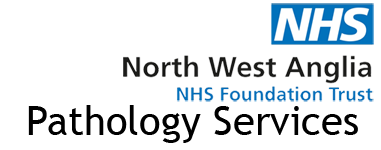Cryoglobulin
|
Assay |
Cryoglobulin |
|
Key Words |
Cryo, cryoprecipitins |
|
Specimen Collection |
1 x Serum (white) 2 x Plasma (red), specific specimen handling requirements, please see below for further details. Samples must be collected and returned to the laboratory Mon-Fri before 1pm to allow for sample preparation procedures |
|
Turnaround time |
1 week for initial analysis, further confirmatory investigations may take an additional week if required |
|
Test indications |
Cryoglobulins are immunoglobulins that precipitate when cooled to 4oC and dissolve when warmed to 37oC. They occur in a number of diseases associated with hypergammaglobulinaemia. If a cryoglobulin precipitation is identified then the precipitate is removed from the serum and electrophoresis and immunofixation performed to classify and quantify the cryoglobulin fraction. |
|
Methodology |
Protein electrophoresis and Immunofixation |
|
Interferences |
No known common methodological interferences. Samples handled incorrectly, i.e. not kept at 37oC |
|
Reference Range |
Qualitative result: None detected or Positive. All positive results (sample volume dependent) will have the cryoglobulin classified. Classification is as follows: · Type I cryoglobulin - Monoclonal cryoglobulin with no Rheumatoid Factor activity, associated with multiple myeloma, Waldenstrom’s Macroglobulinaemia, MGUS, lymphoproliferative disease · Type II cryoglobulin - Monoclonal cryoglobulin with Rheumatoid Factor activity, associated with chronic Hep B/C virus, lymphoproliferative disease, HIV, Sjogrens syndrome, autoimmune disease · Type III cryoglobulin - Polyclonal cryoglobulin with Rheumatoid factor activity, associated with chronic infections, (EBV, HIV, CMV, hepatitis), TB, leprosy, autoimmune/connective tissue disease, SLE, RA, IBD
|
|
Analytical error |
N/A |
|
Reference change value |
N/A |
|
Minimum retesting interval |
(No minimum retesting interval in place). |
|
Additional Information |
Specimen Handing- Please follow the procedure outlined below when taking samples:
1. Please contact the laboratory to arrange a time to use and pick up the sample incubator (This should be a time when the patient is available and ready to have their blood sample taken). The incubator will contain all the necessary pre-heated samples tubes and needles required for venepuncture. 2. Collect the incubator from the Laboratory , PCH Floor 4, Core C, room 4.PAT.100 and go directly to the patient. 3. Please use the pre-heated needles provided during the venepuncture process. Failure to use the pre-heated needles (e.g. using alternative needles or a syringe) can invalidate the test as cryoglobulins may precipitate out. If you are unable to use the needles provided please contact the laboratory (bleep 1150) for further advice. 4. Follow the venepuncture process using the Sarstedt collection system, collecting the blood into the pre-heated plain white 10ml tube first, then the two red 3.4ml EDTA tubes. (Ensure that the lid of the incubator is closed as all times when you are not directly using it.) 5. Immediately label the specimens, at the patients bedside, with the patient information from the patient's wristband (If available). 6. As soon as the samples are labelled , place the collected samples into the incubator, and return the incubator to the laboratory (PCH Floor 4, Core C, room 4.PAT.100) immediately. Any delay in returning the incubator to the laboratory could invalidate the test. 7. Upon returning the incubator and samples to the laboratory, ensure they are handed to a member of the Clinical Biochemistry and Immunology area.
If you have any issues regarding the sample collection process please contact the laboratory via x8455 or Bleep 1150.
|



